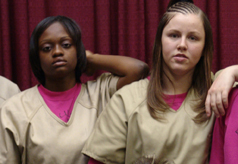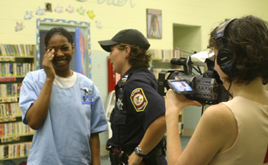Girls on the Wall: The Power of a Girl’s Story
Written by Tabby Biddle
 Meet Whitney. She is 17 years old, intimidating, tough, and infamous among her peers at Warrenville Correctional Facility in Illinois for a crime she won’t talk about. Whitney is one of Warrenville’s longest-term inmates and the secret she holds not only keeps her locked up in prison, but also locked up and unable to heal on the inside.Whitney is one of a group of incarcerated teenage girls whose journey is documented in “Girls on the Wall,” a film directed and produced by Heather Ross & Sincerely Films. The documentary captures an 8-month journey of the girls of Warrenville as they participate in a theatre workshop.The workshop is led by Meade Palidofsky, known as “Ms. P.” to the girls. Meade is the artistic director of Storycatchers Theatre. She is a playwright and lyricist who has been working for more than 30 years helping young people find their voice and tell their stories through performance art. “It’s a real gift to be able to use what you love to do to get other people to not only learn playwriting and songwriting, but to actually use that process to heal themselves,” she told me in a recent interview.
Meet Whitney. She is 17 years old, intimidating, tough, and infamous among her peers at Warrenville Correctional Facility in Illinois for a crime she won’t talk about. Whitney is one of Warrenville’s longest-term inmates and the secret she holds not only keeps her locked up in prison, but also locked up and unable to heal on the inside.Whitney is one of a group of incarcerated teenage girls whose journey is documented in “Girls on the Wall,” a film directed and produced by Heather Ross & Sincerely Films. The documentary captures an 8-month journey of the girls of Warrenville as they participate in a theatre workshop.The workshop is led by Meade Palidofsky, known as “Ms. P.” to the girls. Meade is the artistic director of Storycatchers Theatre. She is a playwright and lyricist who has been working for more than 30 years helping young people find their voice and tell their stories through performance art. “It’s a real gift to be able to use what you love to do to get other people to not only learn playwriting and songwriting, but to actually use that process to heal themselves,” she told me in a recent interview. Healing is exactly what takes place. As the girls of Warrenville go through the process of creating a musical based on their lives -- journaling about their past, sharing with their peers what feel like shameful secrets, re-living and dramatizing their crimes – a transformation takes place. As these young women begin to open up about their stories, they begin to release their wounds and restore their self-dignity. Furthermore, when they hit the stage in front of their families and prison staff, a profound healing happens for everyone.Watching the documentary at a recent screening in Los Angeles, what
Healing is exactly what takes place. As the girls of Warrenville go through the process of creating a musical based on their lives -- journaling about their past, sharing with their peers what feel like shameful secrets, re-living and dramatizing their crimes – a transformation takes place. As these young women begin to open up about their stories, they begin to release their wounds and restore their self-dignity. Furthermore, when they hit the stage in front of their families and prison staff, a profound healing happens for everyone.Watching the documentary at a recent screening in Los Angeles, what  affected me the most was experiencing the immense talent and sheer beauty within each one of these young women. That’s not the usual perception of prison inmates. “I think when people think of kids that are locked up they think of them as bad kids, evil kids, or dysfunctional kids. They think that for anyone who is locked up, there is something wrong with them.” Even though I might not have wanted to admit it, before I saw “Girls on the Wall” I was carrying around some of those misperceptions.From the film, I quickly learned that these girls are smart, talented, kind, compassionate, funny and incredible young women – all that locked inside the toughness of prison life. Each one of them in their own way was hurt badly through early experiences (usually related to family) and never received the appropriate support to recover. Drug-addicted parents, sexually abusive family members, physical and emotional assault were all common themes for these young women. One young woman’s only crime was running away from foster placements because she wanted to be with her mom who was a crack addict.“When the girls tell their stories it becomes so clear why they are locked up. It usually starts from a trauma they have experienced causing them to be angry and depressed, which causes them to drop out of school, do drugs, join gangs, and eventually become incarcerated. It’s a pretty clear cycle,” says Meade.“I think what people learn when they come in to work with the girls is that what’s dysfunctional is our system. What’s dysfunctional is that we don’t have a lot of systems that work for kids on the outside,” she adds.
affected me the most was experiencing the immense talent and sheer beauty within each one of these young women. That’s not the usual perception of prison inmates. “I think when people think of kids that are locked up they think of them as bad kids, evil kids, or dysfunctional kids. They think that for anyone who is locked up, there is something wrong with them.” Even though I might not have wanted to admit it, before I saw “Girls on the Wall” I was carrying around some of those misperceptions.From the film, I quickly learned that these girls are smart, talented, kind, compassionate, funny and incredible young women – all that locked inside the toughness of prison life. Each one of them in their own way was hurt badly through early experiences (usually related to family) and never received the appropriate support to recover. Drug-addicted parents, sexually abusive family members, physical and emotional assault were all common themes for these young women. One young woman’s only crime was running away from foster placements because she wanted to be with her mom who was a crack addict.“When the girls tell their stories it becomes so clear why they are locked up. It usually starts from a trauma they have experienced causing them to be angry and depressed, which causes them to drop out of school, do drugs, join gangs, and eventually become incarcerated. It’s a pretty clear cycle,” says Meade.“I think what people learn when they come in to work with the girls is that what’s dysfunctional is our system. What’s dysfunctional is that we don’t have a lot of systems that work for kids on the outside,” she adds. I decided to ask Heather, the director and producer of the film, why she thought a girl telling her story was so healing. She told me: “I think a lot of the time girls may feel on some level that their story has been deemed unimportant, especially to the outside world. All kids, and I think especially girls, get used to adults ignoring them. And for these girls in particular, I think the situation is magnified because their marginalized for other reasons -- they're in trouble with the law, most come from families that are barely making it (if at all), and I don't think stories like theirs make it into the media much. I think just realizing that they have a unique story, and that other people might want to hear it, is enough to turn their heads.”
I decided to ask Heather, the director and producer of the film, why she thought a girl telling her story was so healing. She told me: “I think a lot of the time girls may feel on some level that their story has been deemed unimportant, especially to the outside world. All kids, and I think especially girls, get used to adults ignoring them. And for these girls in particular, I think the situation is magnified because their marginalized for other reasons -- they're in trouble with the law, most come from families that are barely making it (if at all), and I don't think stories like theirs make it into the media much. I think just realizing that they have a unique story, and that other people might want to hear it, is enough to turn their heads.”
“Once you tell the story, then you let it go.” – Meade P.
“Girls on the Wall” illustrates that storytelling can help each one of us make sense of our past – and heal even the darkest parts. For Girls on the Wall screenings and air dates, click here. To learn more about Storycatchers Theatre, click here.Tabby Biddle, M.S.Ed., is a writer/editor dedicated to amplifying the voices of women making a positive difference in the world. Her work has been featured by The Huffington Post, The Los Angeles Times, USA Today and other national media. She lives in Santa Monica, CA.
For Girls on the Wall screenings and air dates, click here. To learn more about Storycatchers Theatre, click here.Tabby Biddle, M.S.Ed., is a writer/editor dedicated to amplifying the voices of women making a positive difference in the world. Her work has been featured by The Huffington Post, The Los Angeles Times, USA Today and other national media. She lives in Santa Monica, CA.

